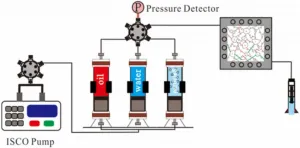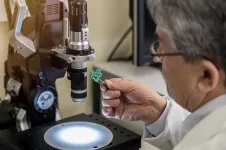(Press-News.org) Our eyes move three times per second. Every time we move our eyes, the world in front of us flies across the retina at the back of our eyes, dramatically shifting the image the eyes send to the brain; yet, as far as we can tell, nothing appears to move. A new study provides new insight into this process known as "visual stabilization". The results are published in the Proceedings of the National Academy of Sciences.
"Our results show that a framing strategy is at work behind the scenes all the time, which helps stabilize our visual experience," says senior author Patrick Cavanagh, a research professor in psychological and brain sciences at Dartmouth and a senior research fellow in psychology at both Glendon College and the Centre for Vision Research at York University. "The brain has its own type of steadycam, which uses all sorts of cues to stabilize what we see relative to available frames, so that we don't see a shaky image like we do in handheld movies taken with a smartphone. The visual world around us is the ultimate stable frame but our research shows that even small frames work: the locations of a test within the frame will be perceived relative to the frame as if it were stationary. The frame acts to stabilize your perception."
One such example is when someone waves goodbye to you from the window of a moving bus. Their hand will appear as if it's moving up and down relative to the window rather following the snake-like path that it actually traces out from the moving bus. The bus window acts like a frame through which the motion of the hand waving good-bye is seen relative to that frame.
The study consisted of two experiments that tested how a small square frame moving on a computer monitor affected participants' judgments of location. The experiments were conducted in-person: eight individuals including two of the authors; and also online due to the COVID-19 pandemic: 274 participants were recruited from York University of which 141 had complete data. The data were very similar for both types of participants.
In Experiment 1, a white, square frame moves left and right, back and forth, across a grey screen and the left and right edges of the square flash when the square reaches the end of its path: the right edge flashes blue at one end of the travel and the left edge flashes red at the other, as shown in the figure. Participants were asked to adjust a pair of markers at the top of the screen to indicate the distance they saw between the flashed edges. Experiment 1 had two conditions. The first condition, demonstrated in Movie 1, evaluated how far apart the outer left and right edges of the square frame appeared. In this example, the frame travel is longer than the frame size so the red flash is physically to the left of the blue flash. When the frame is moving slowly at the start, we see the flashes where they really are, with red to the left. However, once the frame is moving fast enough, blue is seen left of red. This is where they would be, if the frame were actually stationary. The moving frame fools us by stabilizing our judgments of location. Further on in the movie, the frame briefly fades out to reveal that the red flash is actually to the left of the blue flash, which has been the case the entire time.
The second condition assessed the travel of the frame's physical edge. The left edge flashes at each end of the frame's travel and the distance the frame travels is seen as the space between the two flashes.
The data from both conditions of Experiment 1 demonstrated that participants perceived the flashed edges of the frame as if it were stable even though it was clearly moving, illustrating what the researchers call the "paradoxical stabilization" produced by a moving frame.
Experiment 2 again demonstrated the stabilizing power of a moving frame (see Movie 2)) by flashing a red disc and a blue disc at the same location within a moving frame. The square frame moves back and forth from left to right while the disc flashes red and blue in alternation. As in Experiment 1, participants were asked to indicate the perceived separation between the red and blue discs. Even though there is no physical separation between the discs, the moving frame creates the appearance that the two discs are located to the left and right of their true locations, relative to the frame where they flashed. In other words, participants perceived the location of the discs relative to the frame, as if it were stationary and this was true across a wide range of frame speeds, sizes, and path lengths.
"By using flashes inside a moving frame, our experiments triggered a paradoxical form of visual stabilization, which made the flashes appear in positions where they were never presented," says Cavanagh. "Our results demonstrate a 100% stabilization effect triggered by the moving frames - the motion of the frame has been fully discounted. These data are the first to show a frame effect that matches our everyday experience where, each time our eyes move, the motion of the scene across our retinas has been fully discounted making the world appear stable."
"In the real-world, the scene in front of us acts as the anchor to stabilize our surroundings," Cavanagh says. Discounting the motion of the world as our eye move makes a lot of sense, as most scenes (i.e. house, workplace, school, outdoor environment) are not moving, unless an earthquake is occurring.
"Every time our eyes move, there's a process that blanks out the massive blur caused by the eye movement. Our brain stitches this gap together so that we don't notice the blank, but it also uses the motion to stabilize the scene. The motion is both suppressed and discounted so that we can keep track of the location of objects in the world," says Cavanagh.
Based on the study's results, the research team plans to explore visual stabilization further using brain imaging at Dartmouth.
INFORMATION:
Mert Özkan, Guarini '23, a graduate student in the department of psychological and brain sciences at Dartmouth; Stuart Anstis, professor emeritus in psychology at University of California San Diego; Bernard M. 't Hart, a postdoc at the Centre for Vision Research at York University; and Mark Wexler, Chargé de Recherche at the Integrative Neuroscience and Cognition Center at the Université de Paris; also served as co-authors of the study.
Cavanagh is available for comment at: patrick.cavanagh@dartmouth.edu.
A joint paper went out in Journal of Petroleum Science and Engineering.
Petroleum, being a liquid compound, has very good migratory properties, and recovery methods take account of that - using various methods, oilers displace petroleum through cavities and vugs and extract it. However, sometimes oil is "locked" in low-permeability reservoirs, and water displacement used in such cases poses a high risk of reservoir flooding and workplace emergencies.
Many teams work on blocking high-permeability areas in order to make extraction a more controlled and safe process. In particular, there have yet been no efficient agents for reservoirs with high temperatures (up to 140 C) and mineralization (up to 250 grams ...
Professor Hermann Ehrlich places a piece of sponge in an alkaline, copper-containing ammonia solution that simulates a copper bath from the manufacture of circuit boards for electronic components. About 12 hours later the sponge has turned blue - when dry it is stronger than before, but still very light. "At a pH value of 9 the fibers of the spongin open and the organic compounds of the protein change," explains Prof. Hermann Ehrlich. The copper contained in the ammonia solution reacts immediately with the organic components of the spongin, especially with the amino acid residues, and forms the mineral atacamite. "Like a string, nanometer-sized crystals grow along with the spongin fiber," explains the scientist. ...
Olives, well-known for their characteristic bitter taste, are in high demand owing to the popularity of the oil that's derived from them. The health benefits of olive oil are well known, ranging from antiviral, anti-cancer, to even anti-hypertensive effects. These benefits are attributed to "oleuropein," the most abundant olive secoiridoid found in olives.
An efficient method to enhance the quality of plant products is by using molecular methods to manipulate their genes and enhancing their yield. With olives, however, this is still a challenge, because of a lack of sufficient genome data.
So far, the genomes of two European olive varieties have been sequenced. But to fully decipher ...
Lack of data on contraception uptake prior to the pandemic means no clear picture of the impact Covid-19 had on contraception use
Study from Warwick Medical School highlights need to maintain access to contraception during disasters
Researchers recommend making more contraception prescription-free and discuss the benefits and pitfalls of telehealth
Limited data on the uptake of contraception prior to and during crises such as the Covid-19 pandemic could mean unforeseen issues for sexual and reproductive health services, research from the University of Warwick concludes.
It identifies additional barriers that women faced in accessing contraception during the Covid-19 lockdown, including disruption to sexual health services and fears about contracting the virus, as ...
New research shows the UK's COVID-19 management decisions were based on an outdated pandemic modelling structure and suggests a more resilient approach would have been more effective.
In the initial months of the pandemic, regular updates using graphs showing how the R number was behaving was the mainstay of the Government's strategy for tackling COVID-19.
This type of infection transmission is usually mathematically-based on dividing the population into 'compartments'. Such an approach has been criticised for its limited scope and inability to capture critical factors, such as the ...
Results show BAT's Modern Oral nicotine pouches have a comparable toxicant profile to NRTs, which are currently considered the least risky of all nicotine products*†
The Modern Oral products have far fewer and significantly lower levels of toxicants‡ than cigarette smoke
Data demonstrates how BAT is building A Better Tomorrow™ by providing evidence to show how we are reducing the health impact of our business and delivering Tobacco Harm Reduction
London, 16 June: New research published today indicates that BAT's modern oral (MO) products in the form of tobacco-free nicotine pouches have a toxicant profile that is comparable to nicotine replacement therapies (NRTs) and much lower than traditional oral ...
CHAPEL HILL, NC - UNC School of Medicine scientists led a collaboration of researchers to demonstrate a potentially powerful new strategy for treating cystic fibrosis (CF) and potentially a wide range of other diseases. It involves small, nucleic acid molecules called oligonucleotides that can correct some of the gene defects that underlie CF but are not addressed by existing modulator therapies. The researchers used a new delivery method that overcomes traditional obstacles of getting oligonucleotides into lung cells.
As the scientists reported in the journal Nucleic Acids Research, they demonstrated the striking effectiveness of their approach in cells derived from a CF patient and in mice.
"With our oligonucleotide delivery platform, we were able to restore the activity of ...
Stuttgart/Boulder - It is not the first time that spiders have served as biological models in the research field of soft robotics. The hydraulic actuation mechanisms they apply to move their limbs when weaving their web or hunting for prey give them powers many roboticists and engineers have drawn inspiration from.
A team of researchers at the Max Planck Institute for Intelligent Systems in Germany and at the University of Boulder in Colorado in the US has now found a new way to exploit the principles of spiders' joints to drive articulated robots without any bulky components and connectors, which weigh down the robot and reduce portability and speed. Their slender and lightweight simple ...
Magnetic-spin interactions that allow spin-manipulation by electrical control allow potential applications in energy-efficient spintronic devices.
An antisymmetric exchange known as Dzyaloshinskii-Moriya interactions (DMI) is vital to form various chiral spin textures, such as skyrmions, and permits their potential application in energy-efficient spintronic devices.
Published this week, a Chinese-Australia collaboration has for the first time illustrated that DMI can be induced in a layered material tantalum-sulfide (TaS2) by intercalating iron atoms, and can further be tuned by gate-induced proton intercalation.
REALIZING AND TUNING DMI IN VAN-DER-WAALS MATERIAL TaS2
Searching ...
WASHINGTON --Just a small number of cells found in tumors can enable and recruit other types of cells nearby, allowing the cancer to spread to other parts of the body, report END ...





